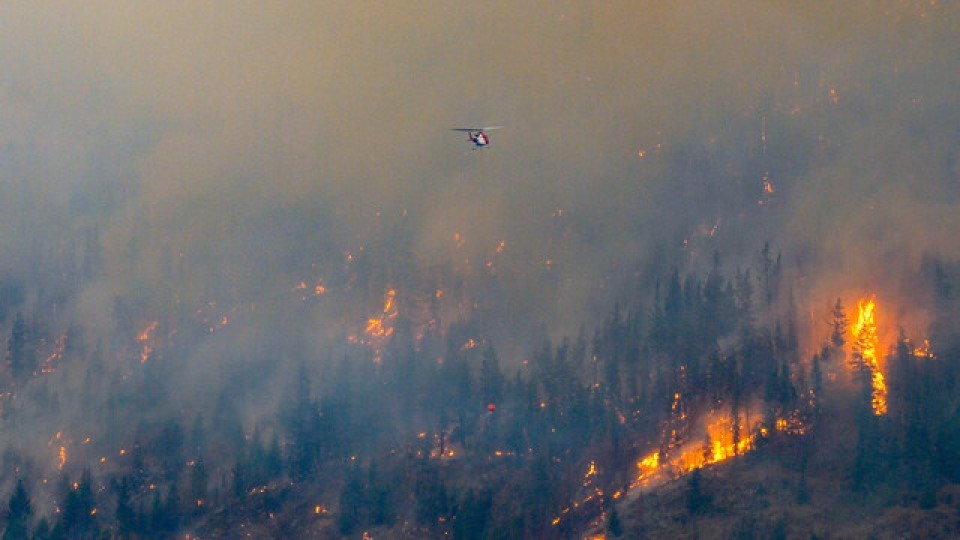The intention of this letter is to examine current wildfire management in BC, by using the Shuswap fire as an example and to propose constructive ways to do better in forest fire season.
The Adams Lake Complex fire started on July 6, 2023, burning for five weeks before persistent dry weather and a cold front, with resulting wind changes, led to the events of August 18. As of August 31, the fire spanned more than 43,000 hectares. It destroyed 180 structures, left hundreds of people evacuated and many homeless, closed the Trans-Canada Highway for a week, and lost revenue for local businesses. This is one of many fires in BC and western Canada this year.
While we are not clear on why this fire was left to burn, despite its proximity to populated regions and worsening conditions, we suspect that BCWS had limited resources. Why wasn't this fire put out when it was small? Why did it get out of control? Is funding for the B C Wildfire Service insufficient?
What are the costs of letting this one fire burn?
- Release of greenhouse gas into the atmosphere: According to Werner Kurz, a senior research scientist at the Pacific Forestry Center in Victoria, BC, burning 1 hectare of boreal forest emits 170 tons of carbon dioxide. The average vehicle emits 4.6 tons of C02 yearly. The Adams Lake/Bush Creek East fire likely released the same amount of carbon dioxide as 1,560,000 cars this year (about half of all registered vehicles in BC). On a national scale in 2023, with over 15 million hectares of forest burned, a rough calculation suggests this is equivalent to the carbon footprint of over 500 million vehicles (more than 20-fold all the vehicles registered in Canada).
- Loss of stumpage and income from logging. If one hectare of BC forest can produce $25,000 in income, this fire may have consumed over a billion dollars of forestry income. Salvage logging brings a fraction of those profits to British Columbians. This burned forest will not be absorbing much C02 for years to come. Forests are 'carbon sinks', when healthy.
- Loss of homes, properties, businesses, likely over $200 million dollars.
- Increases in firefighting costs due to catastrophic conditions and critical infrastructure rebuilding (hydro, water, roads and bridges, etc.)
- Human suffering — loss of homes and businesses, trauma and grief, smoke exposure, and working conditions for firefighters that will lead to burnout. What is the long-term effect on people's health from breathing in smoke for many weeks?
- Death of wildlife and loss of habitat
This one fire did all this damage, and yet it could have been extinguished weeks earlier for a few million dollars. Canada has just 106 dispatchable water bombers, spread over 10 provinces, according to CBC. Some are more than 40 years old. Water bombers and helicopter are the only way to put out fires in inaccessible areas. These craft can attack fires quickly, depending on weather. Canada has the planes, the water and the fuel to fly them. When these water bombers are not in use in Canada, they can be put to good use, helping other countries fight forest fires.
De Havilland builds world class water bombers in Calgary, Alberta. Many are sold to other countries. According to De Havilland, there are no orders for their planes from Canada! Europe has ordered 24 at this time. Production of the new DH-515 water bomber will begin in December 2023. Water bombers cost about $35 to $40 million to construct. $4 billion Canadian dollars would buy a fleet of approximately 100 water bombers. This fleet could be located centrally in Canada; to be dispatched to areas with increased fire risk.
Do you think $3 billion is a lot of money? Those carbon taxes we all pay are currently raising $20 billion a year. So far, that carbon tax is having little or no effect on our rising carbon dioxide levels. Canada has agreed to pay up to $28 billion in incentives to subsidize Volkswagen and Stellantis -LG EV battery plants in Ontario. Why are we not putting more money into fighting forest fires? The C02 produced from forest fires is massive!
Global warming is occurring as carbon dioxide levels rise. Our forest fire situation will get worse. We do not blame the brave firefighters or the BC Wildfire Service. The responsibility for that lies with our current provincial and federal governments. Instead, we are spending massive amounts of money on projects that will make less difference than protecting our forests.
Let's double the number of water bombers and provide more funds to improve our wildfire fighting abilities. This year we failed at that. Let's do better.
Please send this letter on. Governments are like elephants; they move slowly, but if prodded by enough small spears, can be influenced to act.
Chris and Marg Parfitt
Salmon Arm



